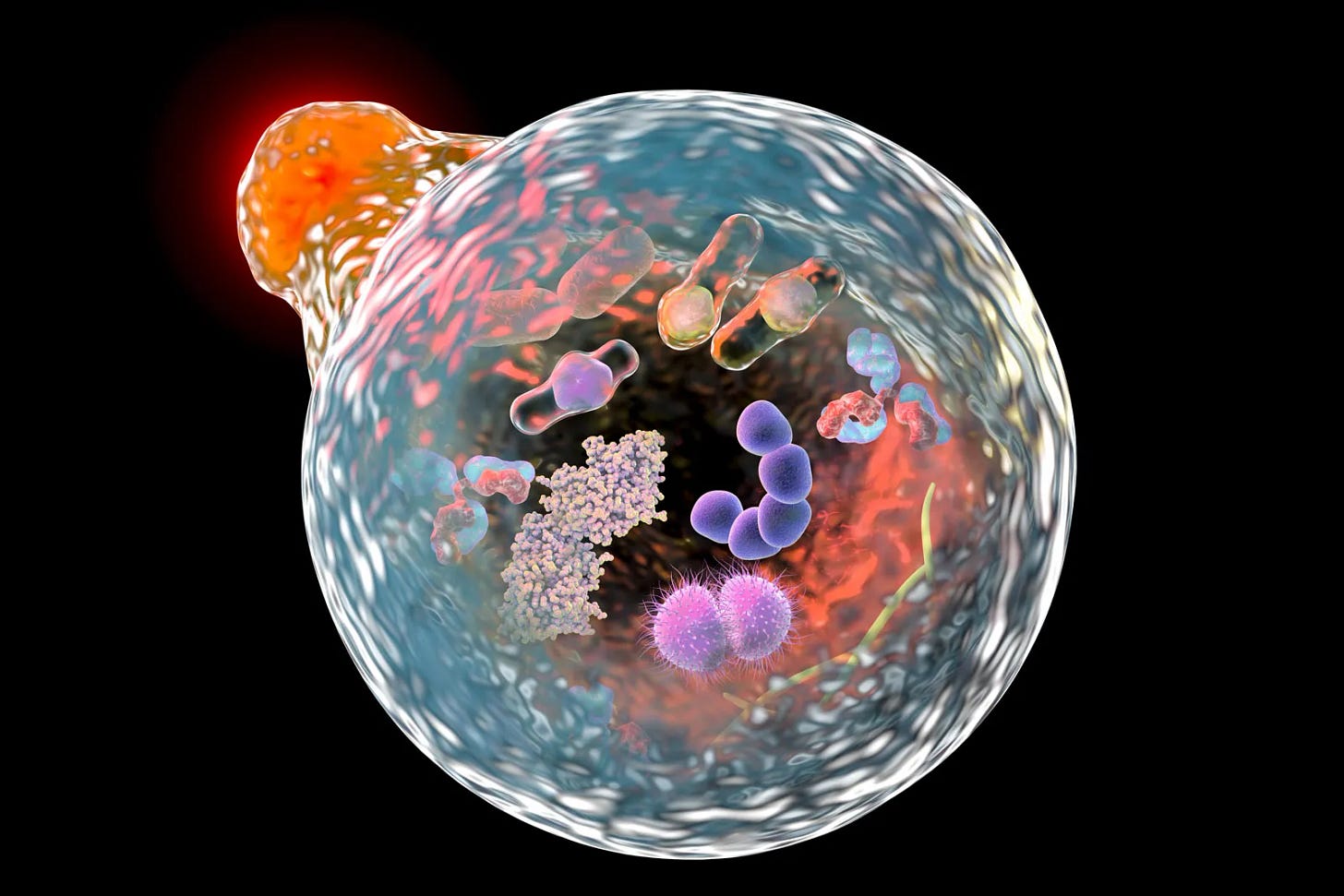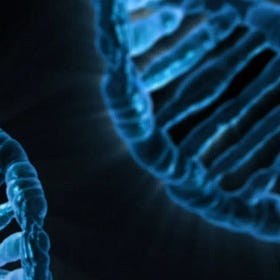In the quest for longevity and optimal health, working to understand the body's natural processes for maintaining cellular integrity and function seems like a good place to start. One such process that has garnered significant attention in recent years is autophagy—a fundamental mechanism by which cells degrade and recycle their own components.

What is Autophagy?
Autophagy, derived from the Greek words "auto" (self) and "phagy" (eating), appears to be one of the body's ways of cleaning out damaged cells and regenerating newer, healthier cells—like the body's internal housekeeping system, ensuring that cells function optimally by removing waste, including misfolded proteins1, damaged organelles, and pathogens.
At present, we are aware of three main types of autophagy, each with distinct roles and mechanisms:
Macroautophagy
Microautophagy
Chaperone-Mediated Autophagy (CMA)
1. Macroautophagy: The Bulk Cleanup Crew
Macroautophagy (often simply referred to as autophagy) is the most well-known form and involves the degradation of large cellular components. It’s the process by which cells create double-membrane structures called autophagosomes2 that engulf damaged organelles, protein aggregates, and even invading pathogens. These autophagosomes then fuse with lysosomes, cellular structures filled with enzymes, where the contents are broken down and recycled.
How to Induce Macroautophagy:
Fasting: Fasting is one of the most effective ways known to induce macroautophagy. Studies suggest that fasting for 16-24 hours can trigger the process,34 and prolonged fasting (48-72 hours) can further amplify the effects.56
Exercise: Physical activity, especially high-intensity interval training (HIIT) and endurance exercise, has been shown to stimulate autophagy in muscle cells.7
Ketogenic Diet: A diet high in fats and low in carbohydrates can promote autophagy by mimicking the metabolic state of fasting, where the body shifts to burning fat for energy.8
Potential Benefits:
Cellular Renewal: Macroautophagy removes damaged components, potentially helping to prevent cellular dysfunction.9
Disease Prevention: By eliminating damaged proteins and organelles, macroautophagy may help prevent diseases like Alzheimer's, Parkinson's, and cancer. 10111213
Longevity: Given the suggested benefits above, it is perhaps not surprising then, that enhanced autophagy has also been linked to increased lifespan in various organisms, suggesting it could play a more general role in promoting longevity. 1415
2. Microautophagy: The Subtle Recycler
Microautophagy is a more subtle process where the lysosome directly engulfs only small portions of the cytoplasm.
Unlike macroautophagy, which involves the formation of autophagosomes, microautophagy involves the direct uptake of cytoplasmic material into the lysosome. This form of autophagy is less well understood but is believed to play a critical role in maintaining cellular homeostasis16, especially under stress conditions.
How to Induce Microautophagy:
Nutrient Deprivation: Similar to macroautophagy, nutrient deprivation (especially the depletion of amino acids) can induce microautophagy.17
Oxidative Stress18: Exposure to mild oxidative stress can trigger microautophagy as the cell attempts to remove oxidized proteins and lipids.19
Potential Benefits:
Cellular Maintenance: Microautophagy helps maintain cellular balance by removing excess or damaged cytoplasmic components.20
Stress Response: It plays a role in responding to cellular stress, ensuring that potentially harmful substances are promptly degraded.21
3. Chaperone-Mediated Autophagy (CMA): The Precision Cleaner
Chaperone-mediated autophagy (CMA) is a selective process that targets specific proteins for degradation. Unlike macroautophagy and microautophagy, which involve bulk degradation, CMA is highly selective. It requires the recognition of a specific amino acid sequence in the target protein by a chaperone protein called Hsc70. Once recognized, the target protein is delivered to the lysosome, where it is unfolded and transported across the lysosomal membrane for degradation.
How to Induce CMA:
Fasting and/or Caloric Restriction: CMA appears particularly responsive to nutrient deprivation, and long-term caloric restriction has been shown to upregulate CMA activity, typically becoming more active after 24-48 hours of fasting when the body needs to conserve energy and selectively degrade proteins involved in metabolism.222324
Heat Stress: Practices like sauna use can potentially induce CMA by increasing the expression of heat shock proteins, including Hsc70, which are essential for this form of autophagy.25262728
Potential Benefits:
Selective Protein Degradation: CMA selectively removes damaged or unnecessary proteins, preventing their accumulation and associated cellular dysfunction.
Metabolic Adaptation: During fasting, CMA appears to help the body adapt by degrading enzymes involved in glucose production, thereby conserving energy.
Aging and Disease Prevention: Declining CMA activity is associated with aging and neurodegenerative diseases. So, enhancing CMA may help mitigate these effects and promote healthy aging.293031
The Synergy of Autophagy Pathways
Each form of autophagy appears to play a distinct yet complementary role in maintaining cellular health. While macroautophagy handles bulk degradation, microautophagy fine-tunes cellular composition, and CMA provides precise control over specific proteins. Together, these processes seem to essential in ensuring that cells remain functional and resilient in the face of stress and aging.
Practical Tips for Enhancing Autophagy
To harness the benefits of autophagy, consider incorporating the following practices into your lifestyle:
Intermittent Fasting: Adopt a fasting regimen, such as the 16:8 method, where you fast for 16 hours and eat within an 8-hour window. This practice helps induce macroautophagy and CMA.
Regular Exercise: Engage in both aerobic and anaerobic exercises to stimulate autophagy in muscle cells.
Ketogenic Diet: Experiment with a ketogenic diet or low-carb eating to mimic fasting conditions and promote autophagy.
Sauna Therapy: Incorporate regular sauna sessions to induce heat shock proteins and potentially stimulate CMA.
Caloric Restriction: Consider long-term caloric restriction (under medical supervision, where necessary) to enhance overall autophagic activity and promote longevity.
By enhancing autophagy through fasting, exercise, diet, and other lifestyle practices, you may be helping your body perform its natural cleansing processes, preventing disease, promoting cellular renewal, and potentially extending your lifespan.
Further reading:
Are these 18 things all that's killing you?
Here is a list of the known reasons for aging, combining 12 of the best-supported with 6 additional emerging factors that are under investigation (and some ideas about what you can do to mitigate each):
If there was something here that you really wanted to know more about (or something I got wrong), please let me know in the comments, and maybe you’ll be the inspiration for a future post.
Misfolded proteins are proteins that fold incorrectly, causing them to become toxic and disrupt normal cell function. Current research findings suggest they are a major cause of many age-related diseases, including Alzheimer's, Parkinson's, and Huntington's disease. FURTHER READING
Autophagosomes https://en.wikipedia.org/wiki/Autophagosome
Autophagy Fasting: What You Need to Know Before Starting - https://lifemd.com/learn/autophagy-fasting
Parvaresh H, Paczek K, Al-Bari MAA, Eid N. Mechanistic insights into fasting-induced autophagy in the aging heart. World J Cardiol 2024; 16(3): 109-117 [PMID: 38576517 DOI: 10.4330/wjc.v16.i3.109]
Godar, R. J., Ma, X., Liu, H., Murphy, J. T., Weinheimer, C. J., Kovacs, A., … Diwan, A. (2015). Repetitive stimulation of autophagy-lysosome machinery by intermittent fasting preconditions the myocardium to ischemia-reperfusion injury. Autophagy, 11(9), 1537–1560. https://doi.org/10.1080/15548627.2015.1063768
How Long Do You Need to Fast for Autophagy? https://www.medicinenet.com/how_long_do_you_need_to_fast_for_autophagy/article.htm
Cui, X., Zhang, Y., Wang, Z., Yu, J., Kong, Z., & Ružić, L. (2019). High-intensity interval training changes the expression of muscle RING-finger protein-1 and muscle atrophy F-box proteins and proteins involved in the mechanistic target of rapamycin pathway and autophagy in rat skeletal muscle. Experimental Physiology, 104(10), 1505–1517. https://doi.org/10.1113/EP087601
Liśkiewicz, D., Liśkiewicz, A., Grabowski, M., Nowacka-Chmielewska, M. M., Jabłońska, K., Wojakowska, A., Marczak, Ł., Barski, J. J., & Małecki, A. (2021). Upregulation of hepatic autophagy under nutritional ketosis. The Journal of Nutritional Biochemistry, 93, 108620. https://doi.org/10.1016/j.jnutbio.2021.108620
Cellular dysfunction occurs when a cell's energy production is impaired, or when a cell's ability to compensate for stress is exceeded. This can lead to organ dysfunction and disease. FURTHER READING
Guo, F., Liu, X., Cai, H., & Le, W. (2018). Autophagy in neurodegenerative diseases: pathogenesis and therapy. Brain Pathology (Zurich, Switzerland), 28(1), 3–13. https://doi.org/10.1111/bpa.12545
Chen, H. Y., & White, E. (2011). Role of autophagy in cancer prevention. Cancer Prevention Research (Philadelphia, Pa.), 4(7), 973–983. https://doi.org/10.1158/1940-6207.CAPR-10-0387
Gómez-Virgilio, L., Silva-Lucero, M. D., Flores-Morelos, D. S., Gallardo-Nieto, J., Lopez-Toledo, G., Abarca-Fernandez, A. M., Zacapala-Gómez, A. E., Luna-Muñoz, J., Montiel-Sosa, F., Soto-Rojas, L. O., Pacheco-Herrero, M., & Cardenas-Aguayo, M. D. (2022). Autophagy: A Key Regulator of Homeostasis and Disease: An Overview of Molecular Mechanisms and Modulators. Cells, 11(15), 2262. https://doi.org/10.3390/cells11152262
Zhineng J. Yang, Cheng E. Chee, Shengbing Huang, Frank A. Sinicrope; The Role of Autophagy in Cancer: Therapeutic Implications. Mol Cancer Ther 1 September 2011; 10 (9): 1533–1541. https://doi.org/10.1158/1535-7163.MCT-11-0047
Madeo, F., Zimmermann, A., Maiuri, M. C., & Kroemer, G. (2015). Essential role for autophagy in life span extension. The Journal of Clinical Investigation, 125(1), 85–93. https://doi.org/10.1172/JCI73946
Maximizing Longevity and Healthspan: Multiple Approaches All Converging on Autophagy https://www.frontiersin.org/journals/cell-and-developmental-biology/articles/10.3389/fcell.2019.00183/full
Cellular homeostasis is the process by which cells maintain a stable internal environment. It's essential for a cell's growth, survival, metabolism, and function.
Olsvik, H. L., Svenning, S., Abudu, Y. P., Brech, A., Stenmark, H., Johansen, T., & Mejlvang, J. (2019). Endosomal microautophagy is an integrated part of the autophagic response to amino acid starvation. Autophagy, 15(1), 182–183. https://doi.org/10.1080/15548627.2018.1532265
Sources of oxidative stress include normal metabolic processes; environmental factors (e.g., UV radiation, pollution, pesticides); lifestyle factors (e.g., smoking, alcohol consumption); physical activity (temporary oxidative stress in muscles); immune responses; chronic infections and inflammatory disorders.
Ornatowski, W., Lu, Q., Yegambaram, M., Garcia, A. E., Zemskov, E. A., Maltepe, E., Fineman, J. R., Wang, T., & Black, S. M. (2020). Complex interplay between autophagy and oxidative stress in the development of pulmonary disease. Redox biology, 36, 101679. https://doi.org/10.1016/j.redox.2020.101679
Li, W. W., Li, J., & Bao, J. K. (2012). Microautophagy: lesser-known self-eating. Cellular and Molecular Life Sciences : CMLS, 69(7), 1125–1136. https://doi.org/10.1007/s00018-011-0865-5
Kroemer, G., Mariño, G., & Levine, B. (2010). Autophagy and the integrated stress response. Molecular Cell, 40(2), 280–293. https://doi.org/10.1016/j.molcel.2010.09.023
Chaperone-mediated autophagy https://en.wikipedia.org/wiki/Chaperone-mediated_autophagy
Shabkhizan, R., Haiaty, S., Moslehian, M. S., Bazmani, A., Sadeghsoltani, F., Saghaei Bagheri, H., Rahbarghazi, R., & Sakhinia, E. (2023). The Beneficial and Adverse Effects of Autophagic Response to Caloric Restriction and Fasting. Advances in Nutrition (Bethesda, Md.), 14(5), 1211–1225. https://doi.org/10.1016/j.advnut.2023.07.006
Chaperone Mediated Autophagy in the Crosstalk of Neurodegenerative Diseases and Metabolic Disorders https://www.frontiersin.org/journals/endocrinology/articles/10.3389/fendo.2018.00778/full
Bejarano, E., & Cuervo, A. M. (2010). Chaperone-mediated autophagy. Proceedings of the American Thoracic Society, 7(1), 29–39. https://doi.org/10.1513/pats.200909-102JS
Kaushik, S., & Cuervo, A. M. (2018). The coming of age of chaperone-mediated autophagy. Nature reviews. Molecular Cell Biology, 19(6), 365–381. https://doi.org/10.1038/s41580-018-0001-6
Dokladny, K., Myers, O. B., & Moseley, P. L. (2015). Heat shock response and autophagy--cooperation and control. Autophagy, 11(2), 200–213. https://doi.org/10.1080/15548627.2015.1009776
Autophagy and heat: a potential role for heat therapy to improve autophagic function in health and disease - https://journals.physiology.org/doi/full/10.1152/japplphysiol.00542.2020
Zhang, C., & Cuervo, A. M. (2008). Restoration of chaperone-mediated autophagy in aging liver improves cellular maintenance and hepatic function. Nature medicine, 14(9), 959–965. https://doi.org/10.1038/nm.1851
Impact of Chaperone-Mediated Autophagy in Brain Aging: Neurodegenerative Diseases and Glioblastoma - https://www.frontiersin.org/journals/aging-neuroscience/articles/10.3389/fnagi.2020.630743/full
Cuervo, A., Wong, E. Chaperone-mediated autophagy: roles in disease and aging. Cell Res 24, 92–104 (2014). https://doi.org/10.1038/cr.2013.153





